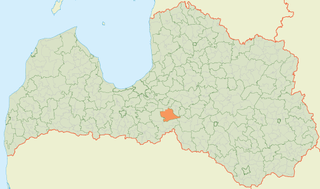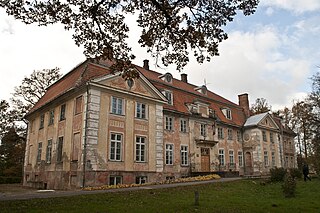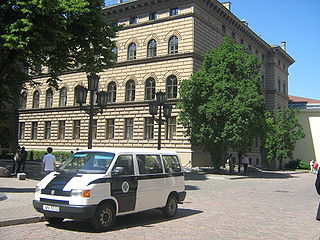
Tukums is a town in Latvia and serves as the administrative center of Tukums Municipality. It is located in the eastern part of the historical region of Courland, and with more than 16,000 inhabitants Tukums is the 13th largest settlement in Latvia. It is also an important railroad junction, connecting the town with Riga, Jelgava and Ventspils. It has two railway stations — Tukums I and Tukums II.

The Baltic German nobility was a privileged social class in the territories of modern-day Estonia and Latvia. It existed continuously from the Northern Crusades and the medieval foundation of Terra Mariana.

Birzgale Parish is an administrative territorial entity of the Ogre Municipality, Latvia. The entire parish is on the left bank of the Daugava, in the region of Semigallia. The parish borders with Tome Parish, Vecumnieki Municipality Vecumnieki Parish and Valle Parish, Jaunjelgava Municipality Jaunjelgava, its rural territory and Sērene Parish, along Daugava with Skrīveri Municipality, Lielvārde Municipality Lielvārde city, its rural territory and Jumprava Parish.

Jaunauce Manor is a manor house in Jaunauce parish in Saldus municipality in the historical region of Courland, in western Latvia.

Aizupe Manor is a manor house built in late classicism style in Vāne Parish, Tukums Municipality, in the Courland region of Latvia. Construction of the manor was completed in 1823. The building housed a forestry school from 1939 to 1985.

Zemīte Manor is a manor house in Zemīte, Zemīte Parish, Tukums Municipality in the Courland region of Latvia. Damaged by fire both in 1905 and 1931, the structure was repaired each time. It currently houses the Zemīte primary school.

Blankenfelde Manor is a manor in Vilce Parish, Jelgava Municipality in the historical region of Semigallia, in Latvia. Built at the last quarter of the 17th century, it changed owners several times. The renovation work is currently being processed.

Šķēde Manor is a manor house in Šķēde Parish, Saldus Municipality in the historical region of Kurzeme, in Latvia.

Vecmēmele Manor is a manor house in Mazzalve Parish, Nereta Municipality in the historical region of Selonia, in Latvia.

Zante Manor is a manor house in Zante, Zante Parish, Tukums Municipality in the Courland region of Latvia. In 1925 it became a school building. From 1953 to 1963 the manor housed the Zante secondary school, but it now houses the Zante primary school.

Palsmane Manor is a manor house built in Eclectic style in the historical region of Vidzeme, northern Latvia.

Stukmaņi Manor is a manor house in Klintaine Parish, Aizkraukle Municipality in the Vidzeme region of Latvia.

Ozolmuiža Manor is an Early Classicism style manor house built for Count George Johann von Mellin at the end of the 18th century in the historical region of Vidzeme, northern Latvia.

Mežotne Palace is a manor house located in Mežotne municipality in Bauska district, in the Semigallia region of Latvia. The palace is one of the most outstanding examples of Neoclassical architecture in Latvia.

Kabala is a village in Türi Parish, Järva County in central Estonia. From 1991 to 2005 it was the administrative seat of Kabala Parish.

The Livonian Knighthood was a fiefdom that existed in Livonia. It was formed in 1561 by Baltic German nobles and disbanded in 1917 in Estonia, and in 1920 in Latvia. Like other Baltic knighthoods, the Livonian also had semi-autonomous privileged status in the Russian Empire.
Sophia von Mengden was a major Baltic German landowner.

Eleja manor house is the name of the ruins of a destroyed manor house, manor complex buildings and the surrounding English landscape garden. It is located in Eleja, Latvia.

Virkeni Manor and the park are located in the village of Virkeni in Latvia, near the border of Estonia. It is located 5 km from the county center Rujiena, 45 km from Valmiera, 150 km from Riga, as well as 75 km from Pärnu and 200 km from Tallinn.

Lubeja Manor is a manor in Liezēre Parish, Madona Municipality in the historical region of Vidzeme, in Latvia.





















